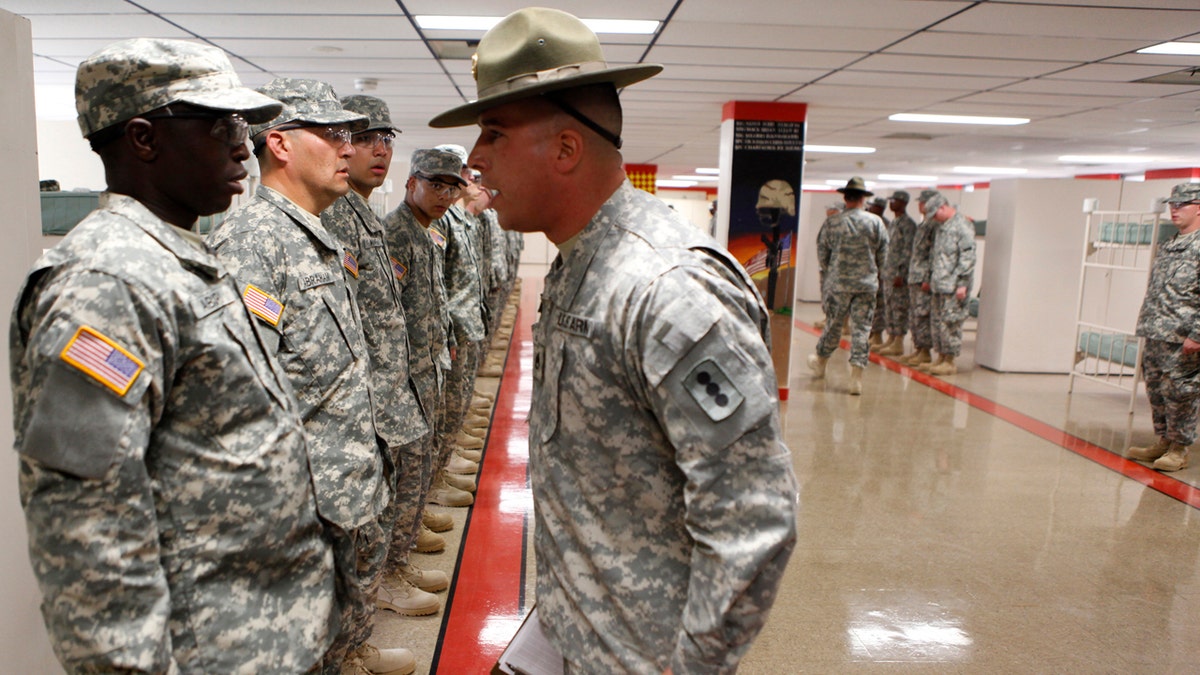
A drill sergeant scolds one of his recruits inside the soldiers barracks during basic training at the Fort Sill Army Post in Fort Sill, Okla. (REUTERS/Jessica Rinaldi)
Citing a disturbing trend of new soldiers lacking both proper discipline and physical fitness, senior U.S. Army leaders are calling for a tougher and longer basic training program to prepare troops for combat over the next decade.
“We have every reason to get this right, and far fewer reasons not to,” Secretary of the Army Mark Esper said at the Association of the United States Army's Global Force Symposium in Alabama on Monday. “That’s why we are considering several initiatives — from a new physical fitness regime to reforming and extending basic training — in order to ensure our young men and women are prepared for the rigors of high-intensity combat.”
While Esper didn’t divulge any details of what an extended Basic Combat Training (BCT) might look like, the Army has already floated the idea of adding two weeks to its 10-week program. A redesigned BCT is expected to be implemented by early summer.
The current BCT involves a three-stage process, the first of which is the “Red Phase.” Comprising the first three weeks of training, it's where recruits begin to learn drills and ceremonies, the seven “Army Core Values, unarmed combat and first aid. Recruits are also introduced to standard-issue weapons like the M-16 assault rifle and M-4 carbine.
In Phase 2, known as the “White Phase,” soldiers begin target practice with their rifles, and become acquainted with other weapons like grenade launchers and machine guns. The recruits also complete a timed obstacle course and learn to work alongside other soldiers.
The final phase, or “Blue Phase,” sees the soldiers complete the Army Physical Fitness Test (APFT), learn nighttime combat operations and go on 10- and 15-kilometer field marches. After passing all their tests, the recruits graduate from basic training and move on to Advanced Individual Training, where they focus on specific skills in their field.
“The ultimate goal of the military is to strip a civilian of civilian status and to put them in a military mindset,” Mike Volkin, an Iraq war veteran and author of “The Ultimate Basic Training Guidebook,” told Fox News. “So if you were to boil down the goal of basic training to its essence it would be to conform.”

A U.S. Army recruit practices securing the area during a chemical weapons exercise at basic training at the Fort Sill Army Post. (REUTERS/Jessica Rinaldi)
The new BCT will place an added focus on strict discipline and esprit de corps through a greater emphasis on drills and ceremony, inspections and military history. It will also concentrate heavily on crucial battlefield skills such as marksmanship, physical fitness, first aid and communications.
Along with the new BCT regimen, U.S. Army brass is considering a tougher Combat Readiness Test, which would replace the current three-event APFT with a six-event test Army leaders believe better prepares recruits for the physical challenges of the service's Warrior Tasks and Battle Drills – the key skills soldiers use to help them survive in combat.
“There’s going to be a much greater emphasis on fitness,” Volkin said. “Throughout the history of basic training, it’s always been about push-ups, sit-ups and the two-mile run, and that’s not a true test of fitness. This six-point test focuses more on core strength and cardio.”
Speaking at the AUSA meeting this week, Esper said that to meet the challenges the U.S. military faces in the next decade – both in combating terrorism and potentially facing off against other large and highly trained militaries – the Army must also reverse its 2017 drawdown. The Army requested 4,000 additional soldiers be added to active forces as part of the 2019 fiscal budget – a move that would swell the ranks to 487,000 active-duty soldiers – with the aim of having half a million active-duty soldiers battle-ready by 2028.

Pvts. Sean Christopher Welliver, left, and John Hubbard, right, drag fellow Pvt. William Weaver (C) through an obstacle course as part of a first aid training exercise. (REUTERS/Jessica Rinaldi)
"To meet the challenges of 2028 and beyond, the total Army must grow," Esper said. "A decade from now, we need an active component above 500,000 soldiers with associated growth in the Guard and Reserve."
But as the Army looks to expand its ranks, it will also become more selective in who becomes a solider.
Gen. James McConville, the Army's vice chief of staff, told Military.com that the service is considering revising its screening process to better prepare recruits for basic training and beyond.
Besides screening candidates’ physical fitness before they begin BCT, the Army would screen them again at the start of training to make sure they can meet the physical demands, and is even testing the idea of assigning fitness experts to two divisions.
"We are putting physical therapists, we are putting strength coaches, we are putting dietitians into each of the units, so when the [new] soldiers get there, we continue to keep them in shape as they go forward," McConville said. "We are going to have to take what we have, we are going to have to develop that talent and we are going to bring them in and make them better.”





















